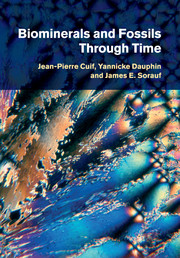Book contents
- Frontmatter
- Contents
- Preface
- Introduction: Milestones in the study of biominerals
- 1 The concept of microstructural sequence exemplified by mollusc shells and coral skeletons
- 2 Compositional data on mollusc shells and coral skeletons
- 3 Origin of microstructural diversity
- 4 Diversity of structural patterns and growth modes in skeletal Ca-carbonate of some plants and animals
- 5 Connecting the Layered Growth and Crystallization model to chemical and physiological approaches
- 6 Microcrystalline and amorphous biominerals in bones, teeth, and siliceous structures
- 7 Collecting better data from the fossil record through the critical analysis of fossilized biominerals
- 8 Results and perspectives
- List of references
- Name index
- Subject index
2 - Compositional data on mollusc shells and coral skeletons
Mineral and organic components viewed from overall characteristics to localized measurements
Published online by Cambridge University Press: 10 January 2011
- Frontmatter
- Contents
- Preface
- Introduction: Milestones in the study of biominerals
- 1 The concept of microstructural sequence exemplified by mollusc shells and coral skeletons
- 2 Compositional data on mollusc shells and coral skeletons
- 3 Origin of microstructural diversity
- 4 Diversity of structural patterns and growth modes in skeletal Ca-carbonate of some plants and animals
- 5 Connecting the Layered Growth and Crystallization model to chemical and physiological approaches
- 6 Microcrystalline and amorphous biominerals in bones, teeth, and siliceous structures
- 7 Collecting better data from the fossil record through the critical analysis of fossilized biominerals
- 8 Results and perspectives
- List of references
- Name index
- Subject index
Summary
When Urey et al. (1951) raised the eventuality of biological influence on isotopic fractionation within a belemnite rostrum from the Isle of Skye, this hypothesis must have seemed surprising because it concerned crystallization of Ca-carbonate, which was then regarded as a physical process governed solely by thermodynamics. Nothing in the earlier crystallization experiments carried out by McCrea (1950) allowed for consideration of possible biological influences. Paradoxically though, if biological influence would then have seemed improbable at the level of isotopic fractionation, more than a century of mineralogical observations and chemical measurements had already definitely established that crystallization of the carbonate of shells and coral skeletons was precisely linked to taxonomy, and therefore biologically controlled. It had been shown long before (Necker de Saussure 1839; Rose 1858) that molluscs produce both calcite and aragonite in a mode of deposition that is specific to each family, and that in certain species these two polymorphs of calcium carbonate are present within the same shell. Just the opposite, while corallites of the Scleractinia are exclusively aragonitic (Sorby 1879), the axes and spicules of corals in the Octocorallia are calcitic. It was understood, though, that the genus Heliopora builds its skeleton of fibrous aragonite.
It was also known that variations in environmental conditions tolerated by each species, and differences in physicochemical conditions which they can support, do not seem to determine whether changes occur in the polymorph of calcium carbonate deposited.
- Type
- Chapter
- Information
- Biominerals and Fossils Through Time , pp. 57 - 118Publisher: Cambridge University PressPrint publication year: 2010



